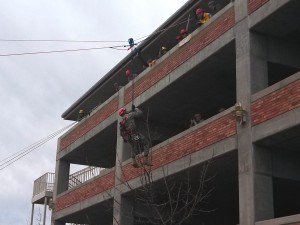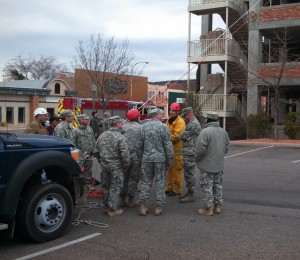
ST. GEORGE – For five days the St. George Fire Department and the Utah National Guard’s 85th Civil Support Team and others will be holding weapons of mass destruction response exercises in the area.

Mori Kessler, St. George News
At least once a year the 85th Civil Support Team comes to St. George to either help train or participate in exercises with the St. George Fire Department. These exercises primarily focus on dealing with response to situations involving hazardous WMDs in a suburban setting, and also deal with aspects of search and rescue.
Capt. Jason Whipple of the St. George Fire Department said the exercises began Wednesday and will go through Sunday. So far the exercises have taken place at the old St. George Airport, Dixie State University, and water treatment plants in Hurricane and St. George.
Saturday morning the Civil Support Teams and St. George Bomb Squad ran an exercise involving “EOD,” or explosive ordinance. In the afternoon they practiced transporting people across “high lines” from the top of the floor of the parking complex by Main Street.
Col. Ken Verboncoeur, commander of the 85th Civil Support Team, said dealing with emergency situations – particularly those of a biological, chemical and radioactive nature – in a suburban setting is the team’s primary goal. However, they also engage in search and rescue and extraction actions.
“Those are our core missions, the suburban functions,” Verboncoeur said. “But we also have the ability to do rope rescue, confined space, search and extraction, trench rescue – those are kind of secondary missions for us.”

Mori Kessler, St. George News
On Sunday the training will be taken to nearby canyons where the five day’s worth of exercises will conclude with canyoneering.
Whipple said the fire department and 85th Civil Support Team weren’t the only parties participating in the exercises. Members of National Guard civil support teams from Nevada, New Mexico and Alaska are also involved.
Each state and territory has its own civil support team, Verboncoeur said. However, three states – California, Florida and New York – each have two teams because of their size and populations. There are 57 civil support teams total.
National Guard CSTs are also more specialized in what they do than regular hazard response teams employed by municipal agencies.
“One of the things that we bring that most agencies don’t have in a hazmat-type response is that we have a portable lab that comes with us,” Verboncoeur said. If a local agency is unsure concerning the nature of a substance or material its people encounter, the CST lab can be rolled out can a “presumptive analysis” can be done in order to get a basic idea of that the local agency is dealing with. Once that is done, they can begin to determine how the situation may impact the civilian populace and plan accordingly.
“We’re lucky enough to have a Ph.D biologist on our team,” he said. “That lends a lot of credibility to our team when we show up on the scene.”
The 85th CST consists of 22 members who are what the Army calls “ARGs,” or Active Guard and Reserves – they are on call 24/7. Members of the CST are also non-deployable, meaning they cannot be sent overseas. They can be sent anywhere within the continental United States, but must first receive permission from the governor who is considered the unit’s commander-in-chief.
The CST itself trains as a unit at least once a month, with exercises and trainings involving other agencies at least three to four times a month.
Email: [email protected]
Twitter: @MoriKessler
Copyright St. George News, SaintGeorgeUtah.com LLC, 2013, all rights reserved.

Mori Kessler, St. George News